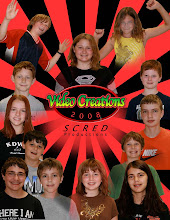I know what you're thinkin'-you're thinkin' this Video Creations class is for kindergartners. You're askin'- where's the meat? You're sayin' Bring it on Mr. S!
Well, (meekly in response) you can show off your mettle by incorporating these 3 big ideas into your productions by the end of SEEK:
1. Progression from simple to complex. This idea works on a number of levels and for a variety of uses. For video production I would like you to think about how this idea works in a shot formula. We have discussed how the audience needs to immediately know answers to the the basic who-what-where questions in order for them to continue following the story. What do your shots have to be like in the beginning, middle, and end of your production? When should the shots have a slower pace, wider point of view, and not too much variety? When should they have a faster pace, more close-ups with a variety of angles? Some movies seem to move from complex to simple. The intent may be to get the audience's attention with fast paced and dynamic shots, but eventually the movie will have to slow down into more simple scenes to give the audience a chance to regroup their thoughts.
2. Affinity and Contrast (Finding and using similarities and differences). To explain these I like to use the first Star Wars movie (Episode IV) as our example. There are numerous scenes where the contrast of good/evil or dark/light are obviously portrayed against each other. And its not just the script you find this. The visuals of the death star scenes with Darth Vader are cold and dark in both color and tone. The scenes with Luke and Obi Wan Kenobi are lighter and warmer in tone and color. There are camera position contrasts, too. Camera angles from Darth Vader's point of view are from a superior (looking down) point of view while the person he is talking to will always be shown from an inferior (looking up) point of view.
3. Point of Focus. The audience's eyes can only pick one part of the screen to watch at a time. Try watching a commercial on TV without the sound on. I bet your eyes will be directed to certain areas of the screen. When we start making our audience's eyes move to the area of the screen we intend, then we are on our way to using video techniques to create a better visual story.
Resource: The Visual Story by Bruce Block
Wednesday, June 11, 2008
Subscribe to:
Post Comments (Atom)



No comments:
Post a Comment